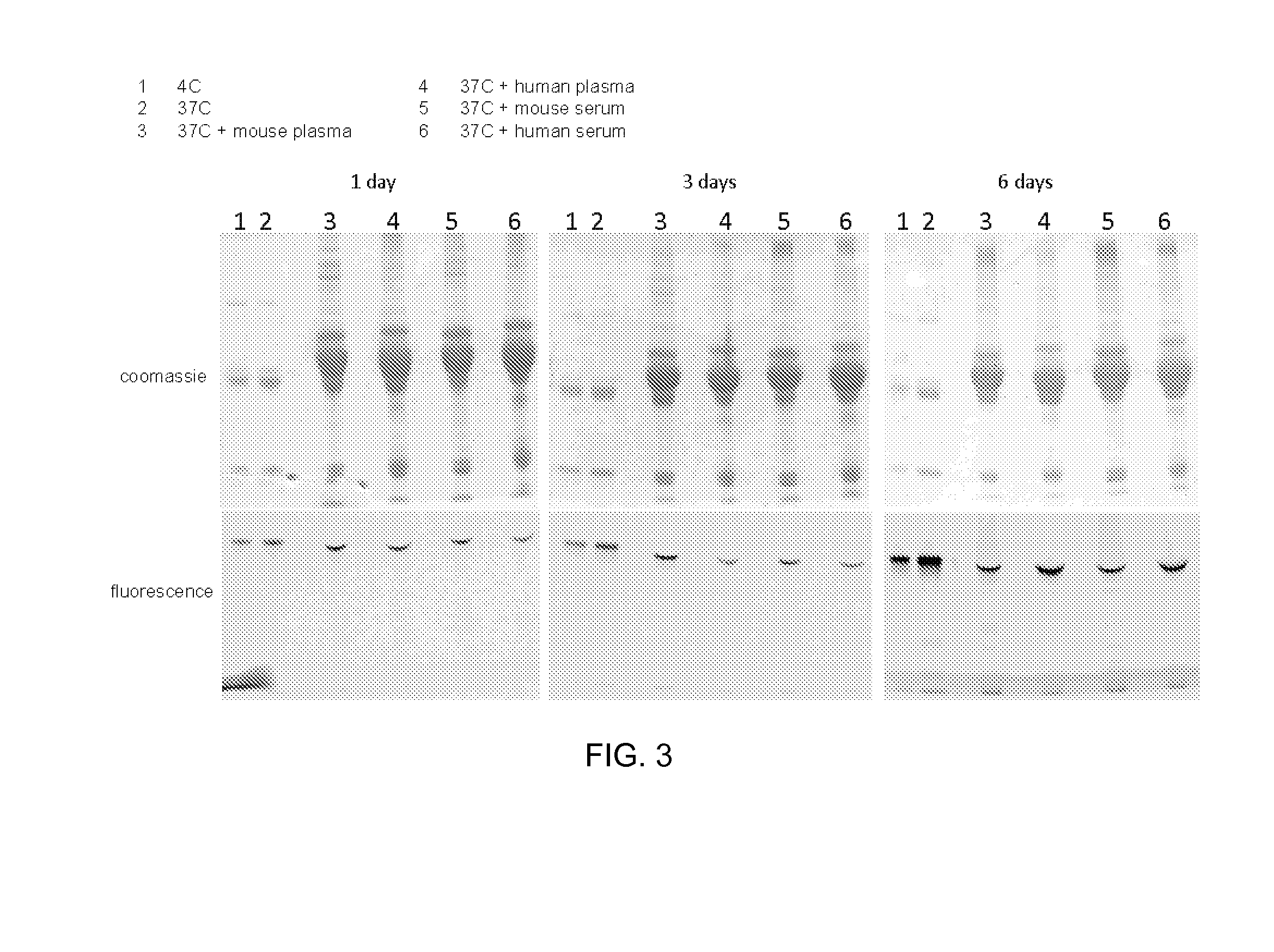Hydrazinyl-indole compounds and methods for producing a conjugate
a technology of hydrozinyl indole and conjugate, which is applied in the direction of antibody medical ingredients, peptide/protein ingredients, instruments, etc., can solve the problems of heterogeneous mixture of conjugates, production of biologically active proteins, and homogeneous forms
- Summary
- Abstract
- Description
- Claims
- Application Information
AI Technical Summary
Benefits of technology
Problems solved by technology
Method used
Image
Examples
example 1
Conjugation of HIPS-A594 to an Aldehyde-Tagged IgG Antibody
[0579]HIPS-AF594 (Compound 80, above) was conjugated to an aldehyde-tagged antibody over a range of time and pH conditions. HIPS-AF594 (92.6 drug:aldehyde equivalents) was reacted with 5.4 μM aldehyde-tagged IgG antibody for 1, 2, 3, 4, or 24 hr at 37° C. in PBS pH 7.4, PBS with 100 mM potassium acetate pH 4.6, PBS with 50 mM sodium citrate pH 6.0, or PBS with 100 mM Tris pH 8.
[0580]Results of the conjugation reaction are shown in FIG. 2, which shows conjugation of HIPS-AF594 to aldehyde-tagged antibody conjugated over a range of pH conditions. FIG. 2A shows a reaction scheme for the synthesis of the functionalized detectable label. FIG. 2B shows a schematic of the conjugation reaction of the functionalized detectable label to the antibody.
[0581]FIG. 2C shows images of SDS-PAGE gels, which were used to analyze the conjugate. The presense of conjugate was determined by fluorescence imaging.
example 2
Stability of Antibody-Detectable Label Conjugate
[0582]HIPS-AF594 (Compound 80, above) (42.4 drug:aldehyde equivalents) was reacted with 5.9 μM aldehyde-tagged IgG antibody for 16 hr at 37° C. in 128 mM sodium chloride and 50 mM sodium citrate pH 6. The unreacted HIPS-AF594 was removed from the reaction mixture by size exclusion chromatography. The resulting antibody-fluorophore conjugate was incubated at 4° C. or 37° C. in either plasma or serum (both human and mouse) for 1, 3 or 6 days. SDS-PAGE was used to analyze the conjugate. The presence of conjugate was determined by fluorescence imaging. As shown in FIG. 3, no free dye was observed in either case and the conjugate had not decomposed.
[0583]Results of the conjugation reaction are shown in FIG. 3, which shows images of SDS-PAGE gels showing the stability of an antibody-detectable label conjugate over a 6 day time period.
example 3
Conjugation of HIPS-6PEG-Maytansine to an Aldehyde-Tagged Antibody
[0584]HIPS-6PEG-Maytansine (Compound 190, above; 231.5 drug:aldehyde equivalents) was reacted with 5.4 uM aldehyde-tagged antibody (A) in PBS with 50 mM sodium citrate pH 6 and 10% DMA at 37° C. The reaction mixture was analyzed after 48 hours.
[0585]Results are shown in FIG. 4, which shows a hydrophobic interaction column (HIC) trace of the aldehyde-tagged antibody conjugated to HIPS-6PEG-Maytansine. The unconjugated (A), mono-conjugate (B), and di-conjugate (C) protein conjugate were observed.
[0586]Additional compounds were synthesized as described below.
General Synthetic Methods
[0587]All reagents were obtained from Sigma-Aldrich, Acros, or TCI and used without further purification except piperidine, which was dried over CaH2 and distilled. Anhydrous solvents were obtained from commercial sources in sealed bottles. Column chromatography was performed with a Biotage Isolera Prime chromatograph. High-pressure liquid ch...
PUM
| Property | Measurement | Unit |
|---|---|---|
| pH | aaaaa | aaaaa |
| temperature | aaaaa | aaaaa |
| pH | aaaaa | aaaaa |
Abstract
Description
Claims
Application Information
 Login to View More
Login to View More - R&D
- Intellectual Property
- Life Sciences
- Materials
- Tech Scout
- Unparalleled Data Quality
- Higher Quality Content
- 60% Fewer Hallucinations
Browse by: Latest US Patents, China's latest patents, Technical Efficacy Thesaurus, Application Domain, Technology Topic, Popular Technical Reports.
© 2025 PatSnap. All rights reserved.Legal|Privacy policy|Modern Slavery Act Transparency Statement|Sitemap|About US| Contact US: help@patsnap.com



